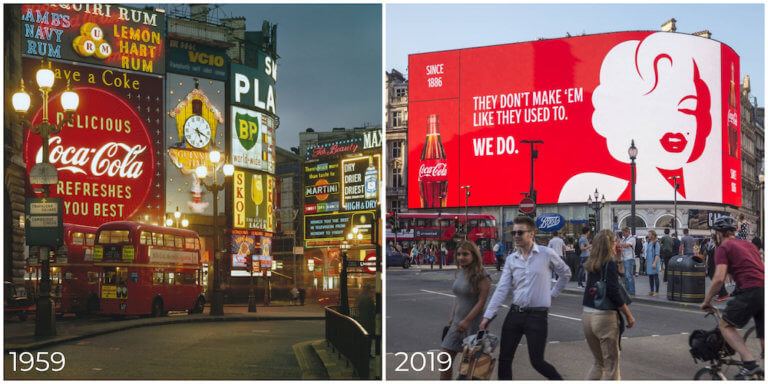
Ever wonder how billboards first emerged? Take Times Square for example, the vibrant colors and lights from billboards illuminate the street corners and are now its trademark. But what is the history behind these billboards? In today’s world, Out-of-Home (OOH) advertising is not only confined to billboards, it consists of a mix of billboards, digital displays, transit ads, street furniture, cinema, place based media, and mobile vehicles such as truck-side ads. OOH is now more powerful and relevant than ever, mainly because of its ability to surround and immerse consumers during the 70% of the day they spend away from their homes. In an age when media fragmentation is increasing due to the abundant amount of advertising mediums available, OOH remains the ideal option to reach people no matter how they consume their media. It is the only medium that can stop people in their tracks, compel them to take notice, and ultimately, buy products. No other advertising presentation is more ubiquitous and more creatively accommodating to our ever-changing society. With such a powerful form of advertising, we can’t help but wonder how it was first introduced and why its legacy continues to live on. In this article, we will take a trip down memory lane and explore the history of OOH and how it has evolved along the way.
The History of OOH
- OOH advertising can be traced back to the earliest of civilizations when Egyptians would build tall structures made from stone to publicize laws and treaties.
- 1450’s : Johannes Gutenberg invented movable type printing and then from there, advertising in the modern sense was launched in the form of the handbill, better known as a flyer.
- 1796: An old-fashioned version of printing called the lithographic process was implemented, where the image to be printed is placed on a plate and then covered with ink. This is when the idea of an illustrated poster came about and the realization of pinning up a flyer instead of handing it out came into play. Bill posters would paste flyers on walls. Even during that time, bill posters that acted as modern advertisers had to prioritize locations and timing based on the amount of exposure. It’s interesting to see that although the medium has changed drastically, the core objective to obtain a high reach remains the same.
- 1830’s: the origin of U.S. billboards was born in the form of posters. Leading up to this date, American merchants would advertise their local stores on roadsides with painted signs and glued posters on the walls directing them to nearby stores. The advertisements were used as a way to notify passersby of certain items that would be of use to them, much like the advertisements we see today that direct us to the nearest store location. During this era, the large American poster that measured over 50 square feet originated in New York by Jared Bell when he began advertising circus posters in 1835.
- 1860’s: The industry for billboards was established. The earliest record of leasing a billboard was dated in 1867.
- 1870’s: There were around 300 companies that provided sign-paintings and bill postings. The International Bill Poster’s Association of North America was then formed in St. Louis in 1872. Towns and cities used billboard advertising to promote their local sights to travelers. Roadside restaurants used them to advertise competitive pricing for hot meals. As the competition began to grow, and the demand for more billboards increased, advertisements started becoming more attractive to entice travelers to stop by their stores and restaurants.
- 1890’s: As the industry continued to grow, the Associated Bill Posters Association of the U.S. and Canada was formed in Chicago which is now known as the Outdoor Advertising Association of America (OAAA). The association’s purpose was to promote a better understanding of the poster advertising medium, expand as a nationwide organization that provides the services of company members, and address any ethical concerns of industry leaders.
- 1901: The standardized billboard structure was officially created in America, which led to a surge in national billboard campaigns. From then on big advertisers like Palmolive, Kellogg, and Coca-Cola began mass-producing billboards as part of their marketing efforts.
- 1908: The Model T car was one of the first cars to be accessible to the masses, therefore cities had to adapt their infrastructure to accommodate with the growing automobile market. This led to the creation of better roads and highways. Advertisers then realized that this would become a prime OOH advertising location.
- 1912: Standardized OOH advertising became available in almost every major urban center.
- 1913: The OOH association established an education committee to encourage members to donate public service advertising to use available billboards for public service messages. This is still practiced to this day. During this time, public service billboards provided support for war efforts and recruiting purposes.

- 1931: Outdoor Advertising, Inc. (OAI) was established to promote OOH advertising, and later merged with OAAA.
- 1925: The first outdoor advertising company was listed on the New York Stock Exchange.
- 1934: The industry established the Traffic Audit Bureau or Media Measurement (TAB) that provides advertisers with third party data about OOH audiences.
- In 1942, the OBIE Awards were introduced to America by OAAA and the first award went to the Coca-Cola “Yes Girl” design.
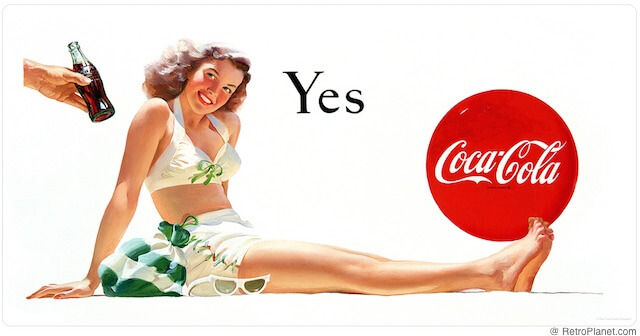
- 1956: The Interstate System was launched connecting different states to one another. By this time, billboards were already gaining popularity, however the creation of the Interstate Highway made billboards a major success.
- 1962: The French OOH advertising company, JCDecaux, introduced advertising on bus shelters, which remain a popular OOH medium mainly because they are built at no cost to municipalities and are maintained by the ad revenue it generates.
- 1965: The Highway Beautification Act was passed. It set limitations on the number of billboards that could be placed along highways and set regulations on size, spacing, and lighting.
- 1970: Billboard companies began replacing hand-painted boards with computer-painted billboards which led to computerized paintings on vinyl.
- 1975: A campaign to measure billboard effectiveness was developed by the OAI. The campaign featured Shirley Cochra, the newly crowned Miss America and was displayed across the country. The results of the campaign showed a 940% increase in her name recognition amongst the public, proving the effectiveness of OOH advertising.
- 2000s : Outdoor advertising companies begin offering a diverse range of OOH mediums including bus shelters, transit, kiosks, airport, mall displays, and mobile billboards.
- 2002: Arbitron and Nielson began testing the possibility of developing outdoor ratings.
- 2005: The first digital billboards were installed.
- Present Day: Digital OOH (DOOH) is becoming more popular and adopting trends like programmatic, augmented and virtual reality, hyperlocal, and mobile integration advertisements. Data measurements and analytics have also come a long way and are now essential to maximize a campaign’s performance. To find out more about the trends of OOH in 2021, give this article a read: https://movia.media/moving-billboard-blog/2021-ooh-advertising-trends/
Why OOH Continues to Thrive
As the world becomes more digitally connected, DOOH is also adapting to the increase in socially connected consumers. New technological advancements are on the rise and constantly evolving in order to engage and excite consumers to not only view an ad but to experience it. By integrating DOOH into a campaign and applying new trends such as programmatic ads and mobile integration, concepts like facial recognition and augmented reality are now achievable. Aside from the advancements offered by DOOH, traditional OOH has also made strides with its measurable tracking ability and unimaginable creativity that never fails to impress its audience. It’s no wonder OOH is the only traditional advertising format to experience consistent growth globally over the last decade with no signs of backing down. Let’s take a look at a brand who played a major role in the evolution of OOH and how they transformed along the way while maintaining their original branding image.
The Coca-Cola Company
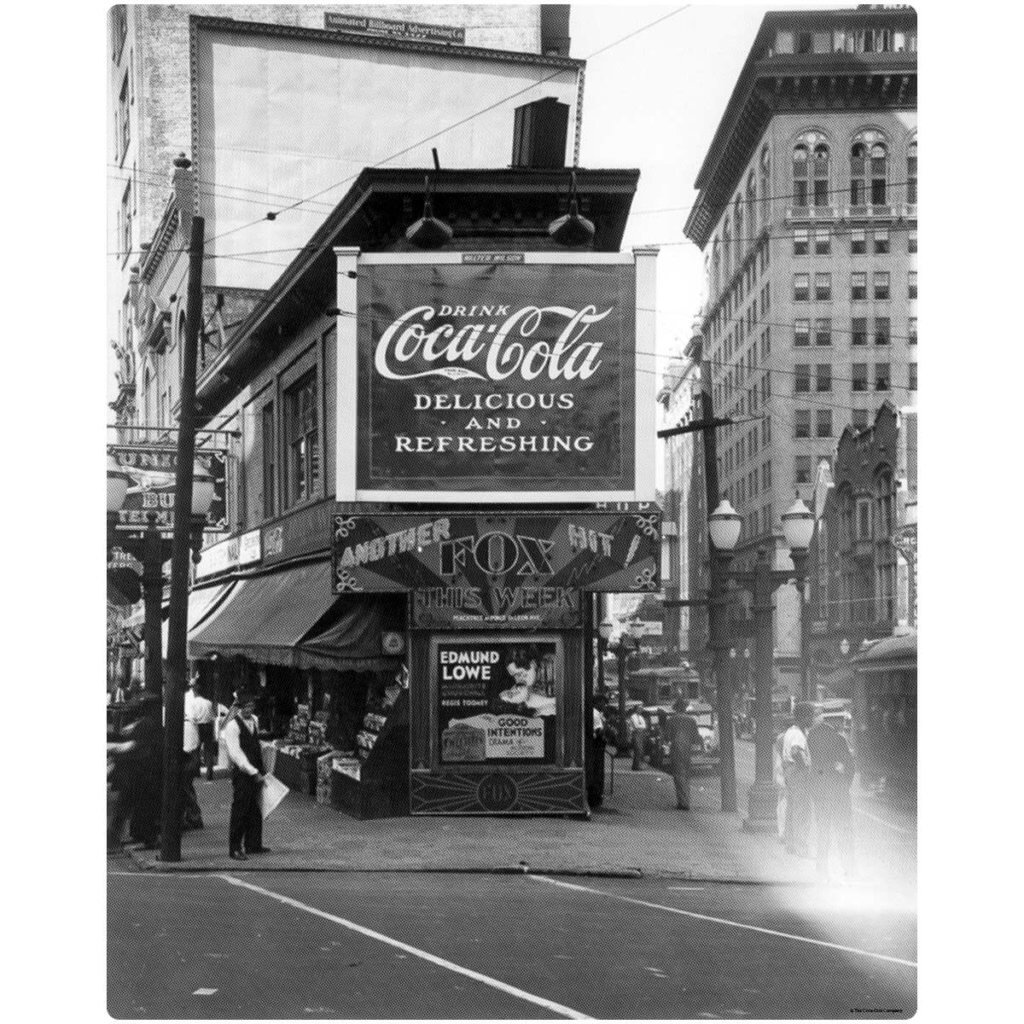
Coca-Cola was one of the first to embrace OOH advertising back in 1886. A milestone for Coca-Cola within the OOH industry, is how they maintained possession of the Piccadilly Circus Lights in London for 50 years. The site is one of the most coveted OOH spots and is believed to be the added extraordinary quality of Coca-Cola, as said by Advertising Director Delony Sledge in 1959.
1955 – Piccadilly Lights
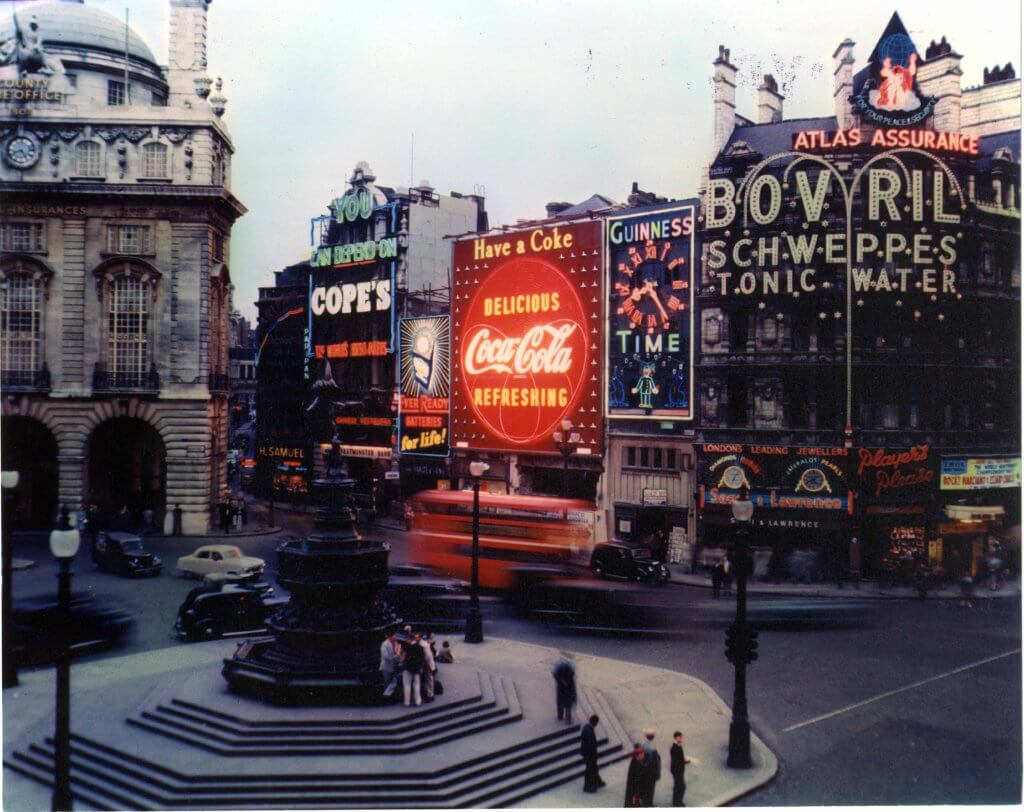
Present Day – Piccadilly Lights

‘Coca-Cola girls’ were all the rage through the 1890s to the 1960s. During this time, illustrations of women in bathing suits and service women from World War I and II were the highlight of the OOH ads. Coca-Cola girls were always portrayed as beautiful, healthy, and happy young women.

What’s even more extraordinary about the Coca-Cola advertisements is the holiday billboard campaign in 1931 that featured an illustrated version of the iconic image of Santa Claus for the first time. Since then, the standard jolly image of Santa Claus that we all know and love today remains and it’s all thanks to Coca-Cola’s OOH advertisement.

From illustrated poster ads to digital and interactive OOH, Coca-Cola has come a long way. To showcase their history and dedication to the medium, they created an OOH campaign to celebrate the coke bottle’s 100th year. The ‘Kissed By’ OOH campaign featured images of iconic stars such as Marilyn Monroe, Elvis Presley, and Ray Charles being ‘kissed’ by the Coca-Cola bottle with the phrase, “I’ve Kissed Marilyn” for the Marilyn Monroe billboard. Who better to represent Coca-Cola as the legendary brand that it is, than the legends themselves!
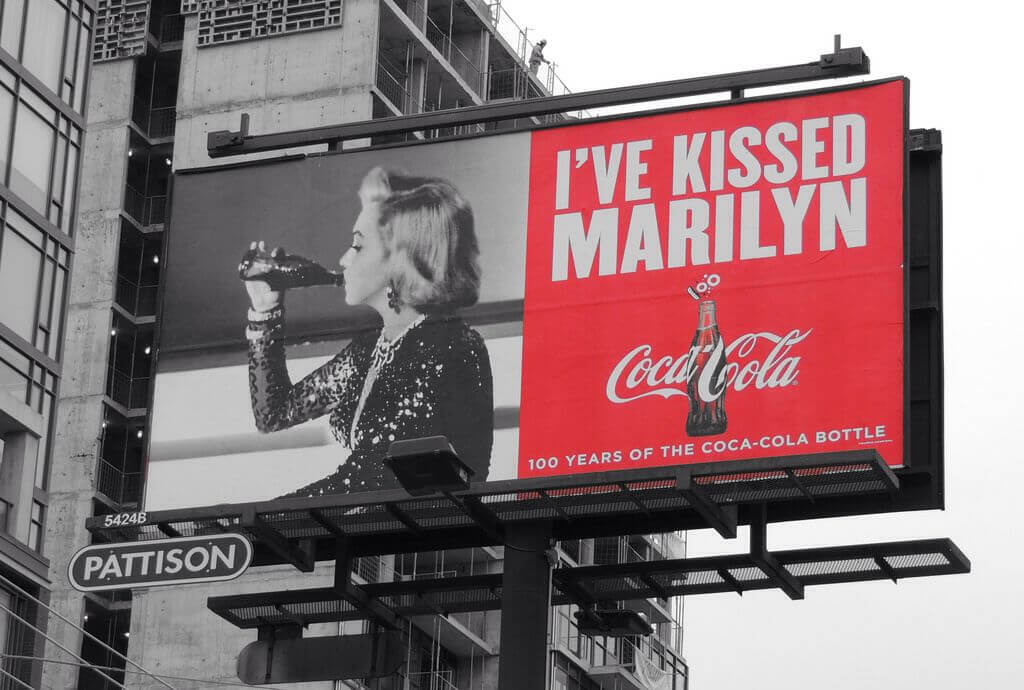
The most recent OOH campaign from Coca-Cola truly showcases that when a brand is as well-known and established as they are, sometimes a creative and minimalistic approach is all you need.
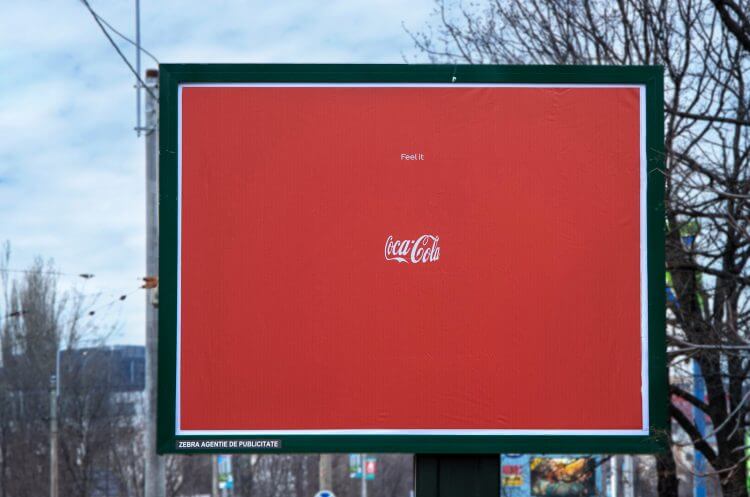
The ad uses nothing but the iconic red and white colors, the logo, and the words “Feel It” to create an optical illusion of the infamous bottle. The campaign was created by Publicis Italy and is located in the Central and Eastern European markets. Being one of the most recognizable logos in the world, our brains can immediately picture the bottle in our minds and ultimately crave it.
The Bottom Line
As history has proven, OOH has stood the test of time with its constant innovation and adaptability to our ever-changing society. The key takeaways from Coca-Cola’s success is their consistent use of OOH advertisements. From its first sign in Piccadilly nearly a century ago, to being one of the world’s most recognized brands today, it distinctively demonstrates how investing in OOH can build a brand for the long run. For a time when the technology to target specific audiences and create intuitive ads did not exist yet, OOH was able to take a soft drink like Coca-Cola and transform it into the iconic paramount brand it is today. With the new technology OOH holds, we can only imagine what brands will be able to accomplish in the years to come.


